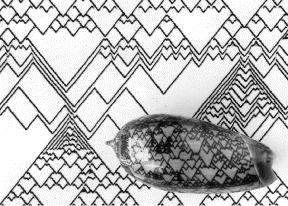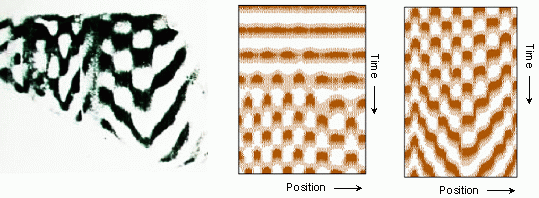Project 4 Sketch – Algorithmic Shells
For this project I’ll be exploring the science behind how sea shells form by implementing the algorithms from Hans Meinhardt’s book The Algorithmic Beauty of Sea Shells.
The complex patterns seen on sea shells are created by relatively simple reactions between antagonistic chemicals that can be described by a set of differential equations. By tweaking the parameters in the equations, most common patterns can be reproduced.
Happily, the book provides source code in BASIC for implementing the differential equations and also has a section on creating seashell-like shapes parametrically in computer graphics environments.
For my project I will re-implement the algorithms described in the book in a modern graphics environment. If time permits, I will export those 3d renderings in a format that can be printed on the full-color powder printer available in the dFab lab.
For the source of these images and more information on the reactions involved, visit this article at the Max Planck Institute.




Hi Max, here are notes from the crit. –GL
———————————————-
Seashells book with code? This is awesome.
^+1
It’s cool that you have so many variables setup that can be changed dynamically. It makes it much easier to explore the generative space you’ve created. Thanks for including more slides at the end about shell formation – this is really pretty interesting stuff.
Or a drill! This looks pretty sweet, the pattern stuff would really change the game on the shell.
Cool interface handle/thingies.
To polish the mesh for fabrication, I think you should focus on the end conditions of the mesh (the point/tip of the shell and the bottom edge where the animal would come out.)
For you to thicken the mesh into a solid, like an actual shell, would be really interesting to take sections through and print.
When you have the nuts-and-bolts worked out, I think you should push the boundaries of the shell algorithm to create new typologies that go beyond shells found on earth……….and then print out an entire taxonomy of those shells. I think replicating the form/pattern is interesting (and challenging!) however I think it would be far more interesting ot leverage the tools you have on hand to create something that is strangely familiar yet otherworldly.
Nice interface for understanding the shape.
Great to have those interface controls. Really helps explain the geometric understanding
Nice interface controls. It seems like you’ve learned a lot through this process.
Good start. Nice to admit being humbled. Making things is hard!
— Is your 3d model suitable for 3d printing, or is it still infinitely thin? Start experimenting with STL output
— Some small amounts of smoothed noise (Perlin, etc) could help the appearance look more organic.
Nice background and research. It was a well planned attempt.
It looks like you did an impressive amount of research into this area. Nice investigation. It will be cool to see what you can output to the 3D printer.
Good job showcasing some of the mathematical ideas and work behnd this. Better lighting in the program would be really helpful.
I think your foundation is set, you can probably do interesting things later. I’m looking forward to it
Strong idea for a generative form. With a little more work it could become really beautiful.
Enjoyed hearing about what you learned.
I can’t wait to see you further this. Keep working!
The research is really solid.